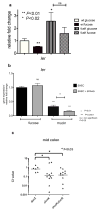Fucose sensing regulates bacterial intestinal colonization
- PMID: 23160491
- PMCID: PMC3518558
- DOI: 10.1038/nature11623
Fucose sensing regulates bacterial intestinal colonization
Abstract
The mammalian gastrointestinal tract provides a complex and competitive environment for the microbiota. Successful colonization by pathogens requires scavenging nutrients, sensing chemical signals, competing with the resident bacteria and precisely regulating the expression of virulence genes. The gastrointestinal pathogen enterohaemorrhagic Escherichia coli (EHEC) relies on inter-kingdom chemical sensing systems to regulate virulence gene expression. Here we show that these systems control the expression of a novel two-component signal transduction system, named FusKR, where FusK is the histidine sensor kinase and FusR the response regulator. FusK senses fucose and controls expression of virulence and metabolic genes. This fucose-sensing system is required for robust EHEC colonization of the mammalian intestine. Fucose is highly abundant in the intestine. Bacteroides thetaiotaomicron produces multiple fucosidases that cleave fucose from host glycans, resulting in high fucose availability in the gut lumen. During growth in mucin, B. thetaiotaomicron contributes to EHEC virulence by cleaving fucose from mucin, thereby activating the FusKR signalling cascade, modulating the virulence gene expression of EHEC. Our findings suggest that EHEC uses fucose, a host-derived signal made available by the microbiota, to modulate EHEC pathogenicity and metabolism.
Figures




References
Publication types
MeSH terms
Substances
Associated data
- Actions
Grants and funding
LinkOut - more resources
Full Text Sources
Other Literature Sources
Molecular Biology Databases

